One of the most common occurrences in waxing is skin lifting or tearing. Professionals should understand the difference between the two so that they can better determine if they can help soothe the client’s skin or if they should refer them for medical attention.
Skin Lifting
When the skin is lifted, it can have a similar appearance to a rug burn. This look is due to the skin being over exfoliated, leaving live skin cells exposed. This shiny appearance occurs more frequently in thinner skin, such as the facial area, such as the eyebrows, the labia, and the scrotum. Lifting can be alleviated with soothing products, particularly alcohol-free products, and equipment. Today, professionals have a good range of safe and natural soothing and calming products available to them. The client should continue to keep the area soothed and clean after leaving the establishment. These types of skin damages are not deep into the dermis and are not generally considered emergencies.
Professionals should familiarize themselves with products that provide safe and quick relief. They should do their research and build confidence in their ability to meet the potential challenges of waxing treatments. An incident report should be filed in case the area becomes further inflamed into something more serious, such as an infection.
Skin Tearing
Skin tearing is a more serious condition because the skin is torn and open, going deeper into the dermis. This occurrence could potentially require stitches or surgical glue. These types of accidents are more prone to infections and require immediate medical attention.
If a salon is noticing a series of lifting and tears, advanced education in proper waxing procedures will help to improve skills, protect the salon’s reputation, and, most importantly, provide safety to clients.
Professionals should not attempt to treat any type of burn. It is recommended that medical professionals tend to the damaged skin. It is also best to remain calm, take care of the client's welfare and well-being by getting them to a doctor, and properly document the incident. Become very familiar with state board laws, the insurance company's policies, and the manufacturer's protocols.
ACCIDENT PREVENTION RECIPE
- Review spa emergency protocols. If the protocol sheet is not posted, get one in place.
- For emergency burns, call 911. For non-emergency burns, the spa manager should help the client get to a doctor. Do not waste time. The client’s safety depends on quick action.
- Do not introduce new products to the situation or try to treat or remedy the skin.
- File a spa incident report.
- Call the insurance company and follow.
- Follow up with the client. The professional and/or the spa manager should call the client to see how they are doing.
- When the client is cleared by the doctor to return for treatments, consider offering them a complimentary service to regain their confidence in the spa.
Preventative and Protective Steps
Because client health is always changing, consultation updates are suggested. Regular updates are important to limit skin reaction surprises. It is also suggested that the waxing waiver be reviewed by the insurance agent and the attorney. This will help to protect the professional in the event of an accident.
Be aware of what coverage the insurance liability policy provides. Many states require advanced certification or add-ons to the policy to cover intimate treatments.
Always follow manufacturer directions. Most insurance coverage only applies to the product lines being carried. Not following a manufacturer's protocol for the use of their products invalidates the insurance coverage because the insurances understand that product lines are formulated to work together for the most effective and safe results.
 Lina Kennedy is a chief pioneer collecting many feathers in her cap. An expert on professional sugaring, Kennedy regularly writes articles for industry magazines in North America and Europe. As president of Alexandria Professional, her goal is to ensure that each professional trained in the art of body sugaring learns and understands the exceptional results that they and their clients can achieve through The Kennedy Theory™ for sugaring and The Kennedy Technique Theory™.
Lina Kennedy is a chief pioneer collecting many feathers in her cap. An expert on professional sugaring, Kennedy regularly writes articles for industry magazines in North America and Europe. As president of Alexandria Professional, her goal is to ensure that each professional trained in the art of body sugaring learns and understands the exceptional results that they and their clients can achieve through The Kennedy Theory™ for sugaring and The Kennedy Technique Theory™.
Want to read more?
Subscribe to one of our monthly plans to continue reading this article.